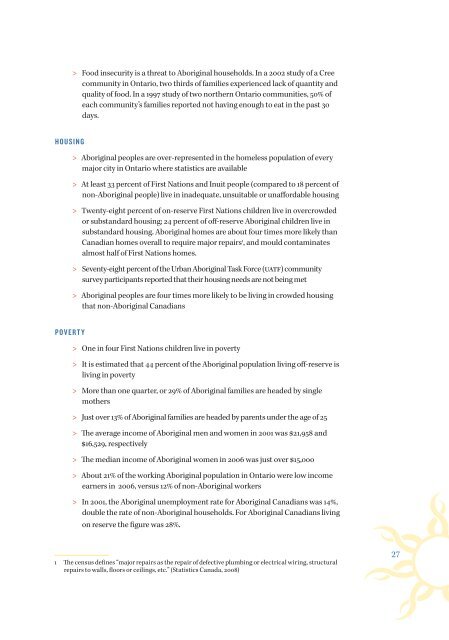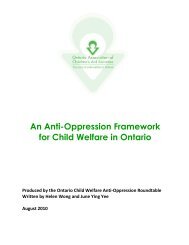English - Ontario Association of Children's Aid Societies
English - Ontario Association of Children's Aid Societies
English - Ontario Association of Children's Aid Societies
Create successful ePaper yourself
Turn your PDF publications into a flip-book with our unique Google optimized e-Paper software.
Food insecurity is a threat to Aboriginal households. In a 2002 study <strong>of</strong> a Cree<br />
community in <strong>Ontario</strong>, two thirds <strong>of</strong> families experienced lack <strong>of</strong> quantity and<br />
quality <strong>of</strong> food. In a 1997 study <strong>of</strong> two northern <strong>Ontario</strong> communities, 50% <strong>of</strong><br />
each community’s families reported not having enough to eat in the past 30<br />
days.<br />
HOUSING<br />
> > Aboriginal peoples are over-represented in the homeless population <strong>of</strong> every<br />
major city in <strong>Ontario</strong> where statistics are available<br />
> > At least 33 percent <strong>of</strong> First Nations and Inuit people (compared to 18 percent <strong>of</strong><br />
non-Aboriginal people) live in inadequate, unsuitable or unaffordable housing<br />
> > Twenty-eight percent <strong>of</strong> on-reserve First Nations children live in overcrowded<br />
or substandard housing; 24 percent <strong>of</strong> <strong>of</strong>f-reserve Aboriginal children live in<br />
substandard housing. Aboriginal homes are about four times more likely than<br />
Canadian homes overall to require major repairs 1 , and mould contaminates<br />
almost half <strong>of</strong> First Nations homes.<br />
> > Seventy-eight percent <strong>of</strong> the Urban Aboriginal Task Force (UATF) community<br />
survey participants reported that their housing needs are not being met<br />
> > Aboriginal peoples are four times more likely to be living in crowded housing<br />
that non-Aboriginal Canadians<br />
POVERTY<br />
> > One in four First Nations children live in poverty<br />
> > It is estimated that 44 percent <strong>of</strong> the Aboriginal population living <strong>of</strong>f-reserve is<br />
living in poverty<br />
> > More than one quarter, or 29% <strong>of</strong> Aboriginal families are headed by single<br />
mothers<br />
> > Just over 13% <strong>of</strong> Aboriginal families are headed by parents under the age <strong>of</strong> 25<br />
> > The average income <strong>of</strong> Aboriginal men and women in 2001 was $21,958 and<br />
$16,529, respectively<br />
> > The median income <strong>of</strong> Aboriginal women in 2006 was just over $15,000<br />
> > About 21% <strong>of</strong> the working Aboriginal population in <strong>Ontario</strong> were low income<br />
earners in 2006, versus 12% <strong>of</strong> non-Aboriginal workers<br />
> > In 2001, the Aboriginal unemployment rate for Aboriginal Canadians was 14%,<br />
double the rate <strong>of</strong> non-Aboriginal households. For Aboriginal Canadians living<br />
on reserve the figure was 28%.<br />
1 The census defines “major repairs as the repair <strong>of</strong> defective plumbing or electrical wiring, structural<br />
repairs to walls, floors or ceilings, etc.” (Statistics Canada, 2008)<br />
27

















